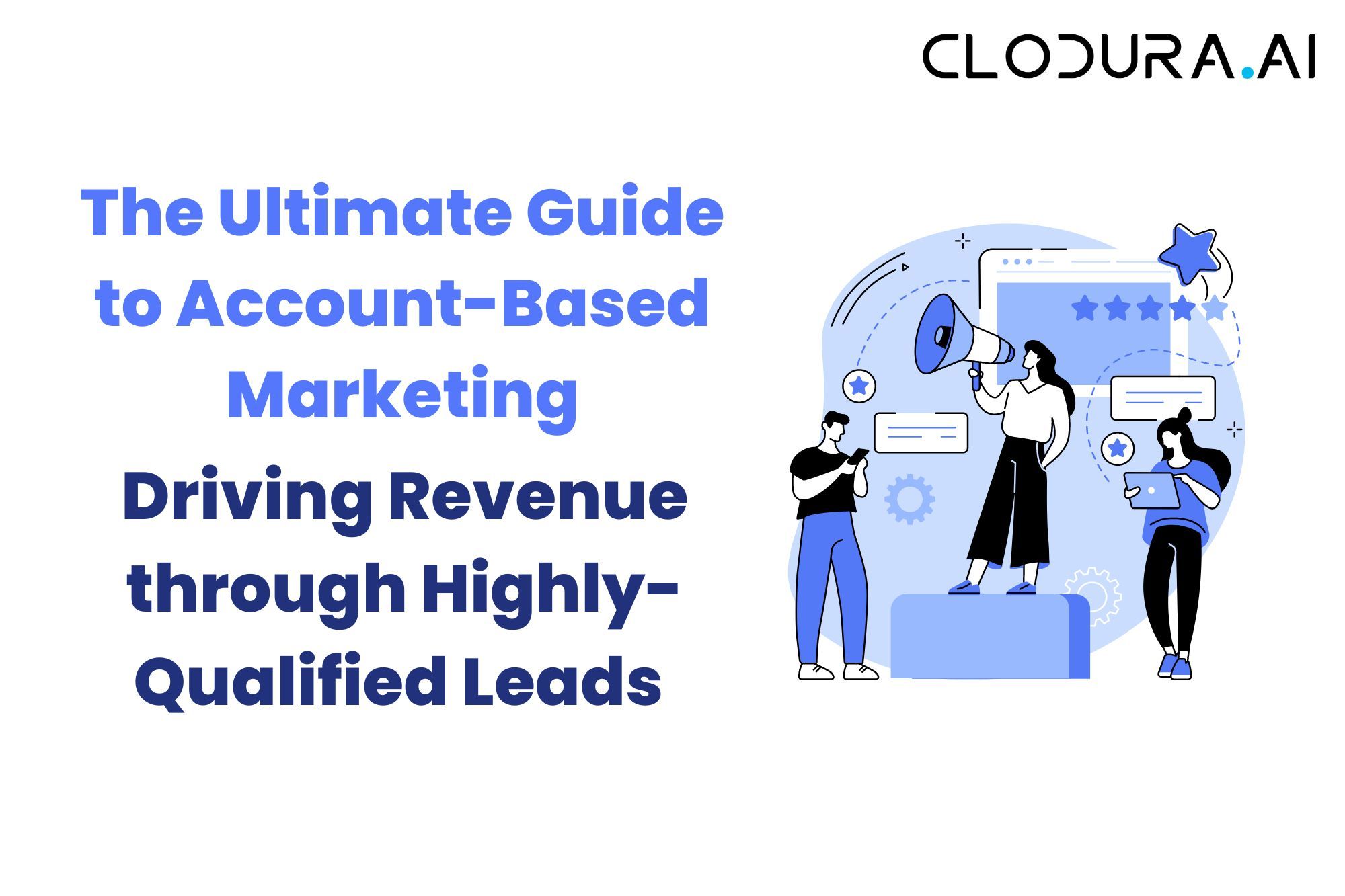Account-Based Marketing (ABM) is a targeted approach to marketing that has gained popularity in recent years. Instead of casting a wide net in hopes of catching leads, ABM focuses on identifying and reaching highly-qualified leads that are most likely to convert into paying customers.
In this guide, we will explore what ABM is, how it can benefit your business, and the strategies and tactics you need to use to make it work for you.
Account-Based Marketing (ABM) has become a popular buzzword in the marketing world over the past few years, and for good reason. This strategy has been proven to be incredibly effective in helping businesses achieve their marketing goals.
But what exactly is ABM, and how can it help your business?
At its core, ABM is a targeted marketing strategy that focuses on a specific set of high-value accounts. Rather than casting a wide net and hoping to attract a large number of leads, ABM is all about identifying the key accounts that are most likely to convert and tailoring your marketing efforts to those accounts.
This involves creating personalized content and messaging that speaks directly to the needs and pain points of those accounts, as well as using targeted advertising and sales outreach to engage with them.
One of the biggest benefits of Account-Based Marketing is that it allows you to focus your marketing efforts on the accounts that are most likely to generate revenue for your business. By targeting high-value accounts that are a good fit for your product or service, you can increase the chances of closing deals and generating a higher return on investment.
This can be especially valuable for businesses that have a limited marketing budget, as it allows you to maximize your resources by focusing on the accounts that are most likely to convert.
Another key advantage of ABM is that it can help you build stronger relationships with your target accounts. By creating personalized content and messaging that speaks directly to the needs and pain points of those accounts, you can demonstrate that you understand their business and are committed to helping them achieve their goals.
This can help to build trust and credibility, which can be invaluable when it comes to closing deals and building long-term relationships with your customers.
“Insights on Account-Based Marketing: Hear from our CEO, Kapil Khangankar - Clodura.AI”
Overall, Account-Based Marketing is a powerful strategy that can help your business drive revenue and reduce costs through highly-qualified leads. By focusing your marketing efforts on a select group of high-value target accounts, you can increase the chances of closing deals, generate a higher return on investment, and achieve a better overall marketing ROI.
So if you're looking to take your marketing to the next level, consider implementing an ABM strategy today!
Strategies for Identifying and Reaching Highly-Qualified Leads
1. The key to success with Account-Based Marketing (ABM) is identifying the right accounts to target:
● ABM is about focusing on a select group of high-value accounts that have the most potential to generate revenue for your business.
● Rather than trying to reach as many leads as possible, ABM focuses on the quality of the accounts being targeted.
2. Analyzing data to identify high-value accounts:
● Analyzing data such as customer lifetime value, revenue potential, and buying behavior can help identify high-value accounts.
● By doing so, you can create a list of accounts that are most likely to have a significant impact on your business goals.
3. Tailoring marketing and sales outreach to reach high-value accounts:
● Personalization is key to catching the attention of highly-qualified leads.
● Creating personalized content that speaks directly to the needs and pain points of the account can be done through targeted landing pages or email campaigns.
● By addressing the unique needs of the account, you are more likely to capture their attention and increase the chances of converting them into customers.
4. Using targeted advertising on social media platforms:
● Social media platforms such as LinkedIn allow for targeted advertising based on job titles, industries, and companies.
● By using this strategy, you can ensure that your advertising is reaching the right people and increasing the chances of converting them into paying customers.
5. Ongoing process of identifying and reaching highly-qualified leads:
● Identifying and reaching highly-qualified leads is not a one-time event, it requires ongoing analysis and adjustments.
● Constantly analyzing data and adjusting strategies is essential to ensure that you are reaching the right accounts and converting them into customers.
● By doing so, you can increase the effectiveness of your ABM strategy and drive significant growth for your business.

How to Measure the Success of Your Account-Based Marketing
- ABM is a highly targeted approach to marketing that involves identifying and engaging with key decision-makers within specific accounts. The main goal of ABM is to focus marketing efforts on accounts that are most likely to convert into paying customers.
- Measuring the success of your ABM efforts is crucial to ensure that you are achieving your business goals and getting a return on investment. One important metric is the percentage of target accounts that convert to paying customers. This metric directly measures the impact of your ABM efforts on your bottom line.
- Other metrics commonly used to measure the success of ABM campaigns include the number of leads generated, the cost per lead, and the overall revenue generated from ABM campaigns. These metrics provide a comprehensive view of the effectiveness of your ABM efforts and help you identify areas for improvement.
- Engagement metrics such as click-through rates and open rates are also important to track. These metrics give insights into the effectiveness of your marketing and sales outreach.
- By analyzing this data, you can refine and optimize your ABM campaigns over time, resulting in better results and higher ROI.
- The quality of your data and the accuracy of your targeting can significantly impact the effectiveness of your ABM campaigns. It's important to regularly review and update your data to ensure that you're targeting the right accounts and decision-makers.
- The alignment between your marketing and sales teams is another critical factor to consider. ABM requires close collaboration between these two teams as they work together to identify, engage, and convert target accounts. By ensuring that your marketing and sales teams are aligned and working towards the same goals, you can maximize the effectiveness of your ABM efforts.

conclusion, measuring the success of your ABM efforts is critical to ensure that you are achieving your business goals and getting a return on investment. By tracking metrics such as the percentage of target accounts that convert to paying customers, the number of leads generated, and engagement metrics such as click-through rates and open rates, you can refine and optimize your ABM campaigns over time, resulting in even better results and higher ROI.
Crafting Effective Account-Based Marketing Campaigns
The success of your ABM campaigns depends on the quality of your campaigns. To ensure your campaigns are effective, it is important to create personalized content that resonates with your target audience.
This could include whitepapers, case studies, webinars, or other digital marketing assets.
However, creating personalized content is just the first step in crafting effective ABM campaigns. It's also important to have a clear understanding of your target accounts and their pain points.
This will help you tailor your messaging and content to better resonate with your audience.
One way to gain insight into your target accounts is to conduct thorough research. This could include analyzing their website, social media presence, and any content they have produced.
You could also reach out to contacts within the organization to gain further insight into their pain points and challenges.
Once you have a clear understanding of your target accounts, it's important to have a clear strategy in place for nurturing leads.
This could include email campaigns, webinars, or personalized content offers to help keep your target accounts engaged and interested in your product or service.
It's also important to track and measure the success of your ABM campaigns. This will help you identify what is working and what isn't, allowing you to adjust your strategy accordingly.
Tracking metrics such as open rates, click-through rates, and conversion rates can provide valuable insights into the effectiveness of your campaigns.
In summary, crafting effective ABM campaigns requires personalized content, a clear understanding of your target accounts, a strategy for nurturing leads, and ongoing measurement and optimization.
By following these steps, you can create campaigns that resonate with your audience and drive results for your business.
Overcoming Challenges with Account-Based Marketing
Account-Based Marketing (ABM) is a highly targeted approach to marketing that focuses on identifying and engaging with key decision-makers within specific accounts.
While it is an effective approach, it does come with certain challenges that need to be overcome to achieve success.
● Overcoming Challenges with Account-Based Marketing
Identifying the right target accounts Identifying the right target accounts is a common challenge in ABM. It requires careful analysis and research to ensure that your selected accounts align with your business goals.
One way to overcome this challenge is to start with a list of accounts that have the greatest potential for revenue growth. This can be based on factors such as size, industry, location, and revenue.
Additionally, you can use data and insights to identify accounts that are actively searching for solutions that your company provides.
● Creating personalized content at scale
Creating personalized content at scale can be another challenge in ABM. It can be time-consuming and expensive to create customized content for each target account. One way to overcome this challenge is to use marketing automation software.
This technology can help you streamline your content creation process by allowing you to create content templates that can be easily customized for each target account. It can also help you automate your content distribution, ensuring that your personalized content reaches the right people at the right time.
Using marketing automation software can also provide valuable insights that can help you optimize your campaigns.
For example, you can use data analytics to identify which types of content are resonating with your target accounts and adjust your strategy accordingly. Additionally, you can use this technology to track engagement metrics such as click-through rates and open rates, giving you insights into the effectiveness of your marketing and sales outreach.
In summary, overcoming the challenges of identifying the right target accounts and creating personalized content at scale can be challenging, but using technology such as marketing automation software can help streamline your ABM processes and provide valuable insights to optimize your campaigns.
Latest Trends and Practices in ABM
● Use of Artificial Intelligence (AI) and Predictive Analytics:
One of the latest trends in ABM is the use of AI and predictive analytics to identify and target high-value accounts. With the help of AI, companies can analyze vast amounts of data to identify patterns and trends that can help them make better decisions about which accounts to target.
Predictive analytics can also be used to determine which accounts are most likely to convert into paying customers.
● Increased Focus on Customer Experience:
Another trend in ABM is the increased focus on customer experience.
Today's buyers expect personalized interactions and highly targeted content. ABM allows companies to provide a personalized experience for their target accounts by creating customized content and messaging that speaks directly to their specific pain points and challenges.
This approach can help companies build stronger relationships with their target accounts and increase the likelihood of conversion.
● Integration with Sales:
Another emerging trend is the integration of ABM with sales.
By aligning marketing and sales efforts, companies can better identify high-value accounts, engage with decision-makers, and move them through the sales funnel more efficiently.
This integration can also help companies better track the effectiveness of their ABM campaigns and make data-driven decisions to optimize their strategies.
● Multichannel Approach:
Today's buyers are using multiple channels to research and evaluate potential vendors, including social media, email, and search engines. To reach these buyers effectively, companies must take a multichannel approach to ABM.
By leveraging multiple channels, companies can engage with target accounts wherever they are and provide a seamless experience across all touchpoints.
● Focus on Metrics and ROI:
As ABM becomes more popular, companies are placing a greater emphasis on metrics and ROI.
Companies are looking to track not only the number of leads generated but also the percentage of target accounts that convert into paying customers, the cost per lead, and the overall revenue generated from ABM campaigns.
This focus on metrics and ROI can help companies make data-driven decisions to optimize their ABM strategies and maximize their return on investment.

Tools you can use for ABM
There are several tools and platforms available to help with ABM, including marketing automation software, CRM software, and social media platforms like LinkedIn.
These tools can help you identify and target high-value accounts, nurture leads, and create personalized content at scale.
It's important to choose the right tools that align with your business goals and integrate well with your existing systems.
To wrapping up,
Account-Based Marketing is a powerful way to drive revenue and reduce costs through highly qualified leads.
By focusing your marketing efforts on a select group of high-value target accounts, you can increase your chances of closing deals, generate a higher return on investment, and achieve a better overall marketing ROI.
With the right strategies and tactics in place, you can successfully implement ABM and see tangible results for your business.
FAQs
Q. What is Account-Based Marketing (ABM)?
A targeted approach to marketing that focuses on identifying and reaching highly qualified leads that are most likely to convert into paying customers.
Q. What are the benefits of ABM?
ABM allows businesses to focus their marketing efforts on the accounts that are most likely to generate revenue, increase the chances of closing deals, and build stronger relationships with target accounts.
Q. How do you identify and reach highly qualified leads for ABM?
Analyze data such as customer lifetime value, revenue potential, and buying behavior to create a list of high-value accounts. Then, create personalized content and use targeted advertising on social media platforms like LinkedIn to reach these accounts.
Q. How do you measure the success of ABM?
Measure the percentage of target accounts that convert to paying customers, the number of leads generated, the cost per lead, and the overall revenue generated from ABM campaigns. Track engagement metrics like click-through rates and open rates, and analyze data to refine and optimize your ABM campaigns over time.
Q. What are some strategies for ABM?
Create personalized content that speaks directly to the needs and pain points of the account, use targeted advertising on social media platforms like LinkedIn, and constantly analyze data to ensure you are reaching the right accounts and converting them into customers.

